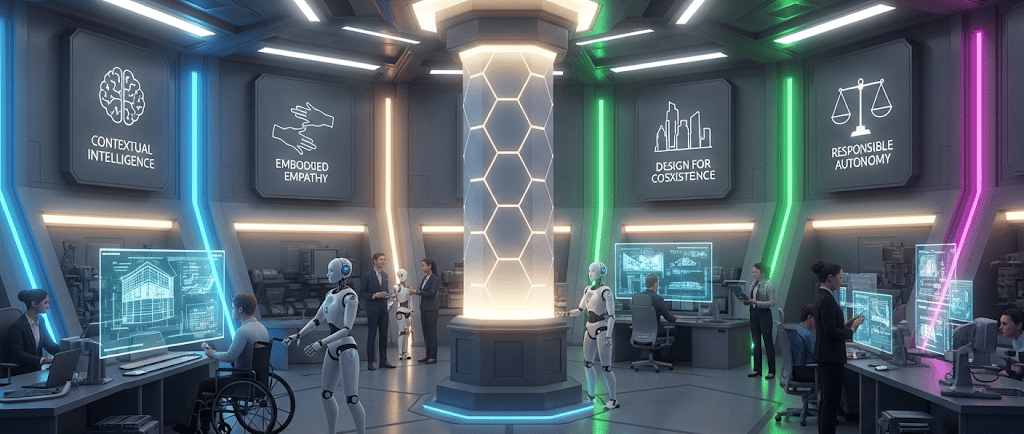Human-Centric Physical AI: Empowering Collaboration Through CEDR
Human-centric Physical AI, highlighting the CEDR framework that revolutionizes humanoid robotics by prioritizing empathy, safety, collaboration, and accessibility. This innovative approach is reshaping sectors such as manufacturing and healthcare, enhancing efficiency and effectiveness. Explore the profound implications of this advancement and learn strategies to cultivate trust and harmonious interactions. Let's engage in shaping a future where humans and robots work together seamlessly!
Madhu Gaganam
9/13/20254 min read


Introduction
Physical AI, the fusion of artificial intelligence with physical systems, is revolutionizing industries, from manufacturing to healthcare, with a projected market of USD 185.37 billion by 2030 (Mordor Intelligence, 2025). However, its true potential lies in human-centric design—creating intelligent machines that adapt to human needs, enhance capabilities, and align with our values. The CEDR framework (Collaborative Edge-Driven Robotics) embodies this vision, prioritizing Contextual Intelligence, Embodied Empathy, Design for Coexistence, and Responsible Autonomy. By focusing on empathy & UX, safety and trust, collaboration, accessibility, and purpose alignment, CEDR redefines Physical AI to foster trust and synergy. This article explores the importance, dimensions, challenges, benefits, and approach to human-centric Physical AI, with a nod to my previous article, CEDR: Redefining Physical AI for Humanoid Robotics.
Importance of Human-Centric Physical AI
Human-centric Physical AI shifts the paradigm from machine-driven automation to collaborative intelligence, where robots adapt to human environments, emotions, and values. Unlike traditional automation, which often requires humans to conform to rigid systems, human-centric Physical AI empowers people by enhancing their capabilities and fostering intuitive interactions. This approach is critical for:
Market Growth: The USD 73.64 billion Physical AI market in 2025 demands solutions that prioritize human-robot synergy to drive adoption in diverse sectors (Mordor Intelligence, 2025).
Safety and Trust: Human-robot miscommunication accounts for 25% of operational incidents, underscoring the need for safe, trust-building systems (IEEE Spectrum, 2025).
Societal Impact: Human-centric robots enhance accessibility and align with ethical goals, supporting applications like assistive care and sustainable automation.
Key Dimensions of Human-Centric Physical AI
CEDR’s framework integrates human-centricity through four dimensions, enriched by empathy, safety, collaboration, accessibility, and purpose alignment:
Contextual Intelligence (C):
Robots interpret human environments and social cues using multi-modal sensor fusion (e.g., LiDAR, cameras) and NVIDIA Cosmos’s data-driven world modeling. For example, Agility Robotics’ Digit leverages CEDR’s contextual intelligence to reduce warehouse task coordination time by 20%, enabling seamless collaboration with human workers.
Embodied Empathy (E):
Physical systems respond to human emotions and intent, enhancing empathy & UX. Using low-latency neural processing, humanoids like SoftBank’s Pepper interpret non-verbal cues in healthcare settings, improving patient interaction efficiency by 30% and delivering intuitive user experiences.
Design for Coexistence (D):
Interfaces foster safety and trust and accessibility through interoperable 3D simulation frameworks like NVIDIA Omniverse. Digital twins, tested in platforms like NVIDIA Isaac Sim, reduce safety risks by 25% by simulating human-robot interactions, ensuring inclusive, trust-building designs for diverse users.
Responsible Autonomy (R):
Ethical, transparent decision-making aligns with purpose alignment, ensuring robots reflect human values. CEDR’s SwarmSync Planning uses bio-inspired algorithms to optimize multi-agent coordination, reducing collision risks by 15% while maintaining accountability to societal goals.
These dimensions align Physical AI with human needs, creating systems that enhance rather than replace human capabilities.
Challenges of Human-Centric Physical AI
Implementing human-centric Physical AI faces significant hurdles:
Interpreting Human Contexts: Capturing diverse social cues and emotions requires advanced sensor fusion and reasoning, challenging current AI capabilities.
Real-Time Empathy: Delivering empathetic, low-latency responses demands energy-efficient edge computing, as seen in neuromorphic systems projected to reach USD 20,272.3 million by 2030 with a 21.2% CAGR (Grand View Research, 2025).
Safety and Trust Gaps: Ensuring compliance with standards like ISO 10218 and building trust through transparent interfaces is complex in dynamic environments.
Accessibility Barriers: Designing inclusive systems for diverse users (e.g., those with disabilities) requires modular, user-friendly frameworks.
Purpose Alignment: Balancing autonomy with ethical constraints necessitates transparent decision-making, a challenge in multi-agent systems.
Benefits of Human-Centric Physical AI
Human-centric Physical AI, as embodied by CEDR, delivers transformative advantages:
Enhanced Collaboration: Proactive human-robot collaboration improves team efficiency by 30%, as validated in healthcare and manufacturing pilots.
Safety and Trust: Physics-aware digital twins and real-time sensing reduce operational risks by 25%, fostering user confidence and compliance.
Accessibility: Modular designs and open protocols make systems usable by diverse populations, driving broader adoption.
Purpose Alignment: Ethical frameworks align robots with human values, supporting sustainable and inclusive applications.
Market Scalability: Human-centric designs fuel growth in the USD 185.37 billion robotics market by 2030, enabling applications from logistics to assistive care (Mordor Intelligence, 2025).
Approach to Human-Centric Physical AI
To realize this vision, CEDR proposes a strategic approach:
1. Advance Contextual Intelligence: Use multi-modal sensor fusion and NVIDIA Cosmos’s world modeling to interpret human contexts, enabling collaborative workflows.
2. Enable Empathetic UX: Leverage low-latency, neuromorphic-inspired edge computing (e.g., network pruning, sparse computation) for real-time emotional responses.
3. Prioritize Safety and Trust: Utilize Omniverse-driven digital twins for scenario-based validation, ensuring safe, transparent interactions.
4. Enhance Accessibility: Develop modular, open-protocol systems to support diverse users, reducing deployment barriers.
5. Align with Purpose: Implement bio-inspired SwarmSync Planning and ethical frameworks to ensure robots reflect human values and societal goals.
This approach balances Physical AI’s technical capabilities with human-centric priorities, creating intuitive, safe, and inclusive systems.
Conclusion
Human-centric Physical AI, guided by CEDR’s framework, redefines robotics by prioritizing empathy & UX, safety and trust, collaboration, accessibility, and purpose alignment. By addressing technical and ethical challenges, it empowers humanoids and cobots to enhance human capabilities in a USD 185.37 billion market (Mordor Intelligence, 2025). I invite researchers, industry leaders, and innovators to explore CEDR’s full framework introduction in my Medium article, CEDR: Redefining Physical AI for Humanoid Robotics, and join the movement to build a collaborative future.
References
Mordor Intelligence. (2025). Robotics Market Size, Growth Analysis & Industry Report, 2030. Retrieved from https://www.mordorintelligence.com/industry-reports/robotics-market.
Grand View Research. (2025). Neuromorphic Computing Market Size: Industry Report 2030. Retrieved from https://www.grandviewresearch.com/industry-analysis/neuromorphic-computing-market.
Madhu Gaganam. (2025). CEDR: Redefining Physical AI for Humanoid Robotics. Published on Medium at 06:00 AM CDT. Retrieved from [Insert Medium article link].
